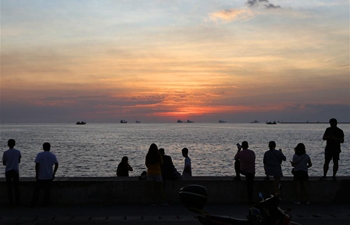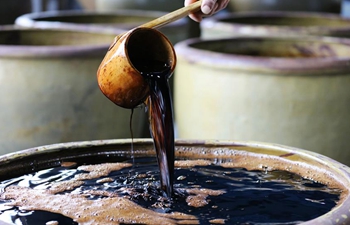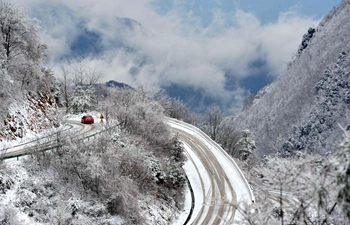ROME, Nov. 19 (Xinhua) -- A rare fresco depicting a sensual scene re-emerged on a wall of a sumptuous Roman house during consolidation works in the ancient Roman city of Pompeii, south of Naples, the Archaeological Park authorities announced on Monday.
The fresco showed "Leda e il Cigno" (Leda and the Swan), and was discovered in a room during re-profiling interventions along a major road of the Regio V area of Pompeii.
It depicted a scene from the ancient Greek myth of Leda and the Swan, telling the union of queen Leda -- wife of King Tyndareus of Sparta -- and god Jupiter (or Zeus), transformed into a swan to seduce her.
The discovery was made on Friday during stabilization works ongoing around the 22-hectare area where archaeologists were carrying out new excavations, a press officer with the Pompeii Archaeological Park told Xinhua.
The room with the Leda and the Swan scene was located "next to the entrance hall, where another fresco depicting Priapus (the ancient Greek god of fertility) had already been identified," Pompeii's cultural authorities also said.
The painting is rich in colors, and quite explicit. It shows Leda sitting on a chair, and only partially dressed in a cloth, with the white swan nestled on her lap.
The woman's eyes point in a way as to meet the gaze of potential observers.
Scenes of sensuality and of explicit sexual acts were not uncommon in arts, during ancient Roman times, as testified by the fresco of Priapus and by others uncovered during excavations in Pompeii and other areas across Italy.
Yet, the "Leda and the Swan" painting was considered "a unique and exceptional finding for such an explicit iconography," Pompeii Archaeological Park Director Massimo Osanna told Ansa news agency.
The ancient Roman urban settlement of Pompeii -- some 40 kilometers south of Naples -- was buried under 4 to 6 meters of ashes and volcanic materials by an eruption of Vesuvius in 79 AD, together with its estimated 11,000 inhabitants.
Along with Herculaneum -- another ancient town also buried by the Vesuvius in 79 AD -- Pompeii's archaeological park was classified as UNESCO World Heritage site in 1997.
It is among the most popular touristic attractions in Italy, registering an annual average of 3.5 million visitors in the period 2015-2017, according to the management.













